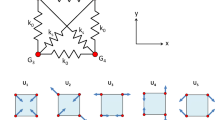Abstract
A crack propagation constraint related to the stress intensity factor is examined for the minimum-weight design optimization of a composite blade-stiffened panel. A low-fidelity approach uses a closed-form solution for the stress intensity factor, while a high-fidelity approach uses the stress distribution around the crack. Structural optimizations are performed by low- and high-fidelity approaches for a number of panels configured with different values of the load, crack length, and blade height. Response surface (RS) approximations are then constructed for the optimal weight as a function of the three configuration variables. The computational cost, numerical noise, and accuracy for the two approaches are compared. An additional constraint in the low-fidelity solutions is found to be active for some of the configurations, increasing the difference between the low-fidelity and high-fidelity optima. It is shown that outlier analysis helps to identify the configurations with the largest difference.
Similar content being viewed by others
References
Anderson, T.L. 1995: Fracture Mechanics: Fundamentals and Applications, 2nd edn. Boca Raton: CRC Press
Gürdal, Z.; Haftka, R.T. 1985: Design of stiffened composite panels with a fracture constraint. Comput. Struct. 20, 457–465
Gürdal, Z.; Haftka, R.T. 1988: Automated design of composite plates for improved damage tolerance. In: Whitcomb, J.D. (ed.) Composite Materials: Testing and Design. ASTM-STP 972, pp. 5–22
Harris, C.E.; Morris, D.H. 1985: A damage tolerant design parameter for graphite/epoxy laminated composites. J. Compos. Techn. Res. 7, 77–81
Holland, P.W.; Welsch, R.E. 1977: Robust regression using iteratively reweighted least-squares. Commun. Stat. Theory Methods 6, 813–827
Khuri, A.I.; Cornell, J.A. 1996: Response Surfaces: Designs and Analyses. New York: Marcel Dekker
Kim, H.; Papila, M.; Mason, W.H.; Haftka, R.T.; Watson, L.T.; Grossman, B. 2001: Detection and repair of poorly converged optimization runs. AIAA J. 39, 2242–2249
Liu, B.; Haftka, R.T.; Akgun, M.A. 2000: Two-level composite wing structural optimization using response surfaces. Struct. Multidisc. Optim. 20, 87–96
Myers, R.H.; Montgomery, D.C. 1995: Response Surface Methodology: Process and Product Optimization Using Designed Experiments. New York: John Wiley & Sons
Nees, C.D.; Canfield, R.A. 1998: Methodology for implementing fracture mechanics in global structural design of aircraft. J. Aircraft 35, 131–138
Papila, M.; Haftka, R.T. 1999: Uncertainty and wing structural weight approximations. 40th AIAA/ASME/ASCE/AHS/ASC Proc. Struct., Struct. Dyn. Mater. Conf. (held in St Louis), Vol. 2, pp. 988–1002
Papila, M.; Haftka, R.T. 2000a: Response surfaces for optimal weight of cracked composite panels: noise and accuracy. 8th AIAA/USAF/NASA/ISSMO Symp. Multidisc. Anal. Optim. (held in Long Beach), AIAA-00-4755
Papila, M.; Haftka, R.T. 2000b: Response surface approximations: noise, error repair and modeling errors. AIAA J. 38, 2336–2343
Papila, M.; Vitali, R.; Haftka, R.T.; Sankar, B.V. 2001: Optimal weight of cracked composite panels by an equivalent strain constraint. 42nd AIAA/ASME/ASCE/AHS/ASC Proc. Struct., Struct. Dyn. Mater. Conf. (held in Seattle), AIAA-01-1207
Poe, C.C. Jr.; Sova, J.A. 1980: Fracture toughness of boron/aluminum laminates with various proportions of 0 and ±45 plies. NASA TP-1707
Poe, C.C. Jr. 1983: A unifying strain criterion for fracture of fibrous composite laminates. Eng. Fract. Mech. 17, 153–171
Ragon, S.A.; Gürdal, Z.; Haftka, R.T.; Tzong, T.J. 1997: Global/local structural wing design using response surface techniques. Proc. AIAA/ASME/ASCE/AHS/ASC Struct., Struct. Dyn. Mater. Conf. (held in Kissimmee), AIAA-97-1051
Rankin, C.C.; Brogan, F.A.; Loden, W.A.; Cabiness, H.D. 1998: STAGS User Manual ver. 3.0. Palo Alto: Lockheed Martin Missiles & Space Co. Inc. Advanced Technology Center
SAS Institute Inc. 1998: JMP Statistics and Graphics, and User’s Guides, Version 3. SAS Campus Drive Cary, NC 27513
Stark, P.B. 2001: SticiGui: Statistics Tools for Internet and Classroom Instruction with a Graphical User Interface. http://oz.berkeley.edu/users/stark/SticiGui (last accessed 10/27/2001)
Thomsen, N.B.; Wang, J.; Karihaloo, B.L. 1994: Optimization – a tool in advanced materials technology. Struct. Optim. 8, 9–15
Vaidya R.S.; Sun C.T. 1996: Fracture criterion for notched thin composite laminates. Proc. AIAA/ASME/ASCE/AHS/ASC Struct., Struct. Dyn. Mater. Conf. (held in Salt Lake City), pp. 331–338, AIAA-96-1354
Vaidya R.S.; Klung J.C.; Sun C.T. 1997: Effect of ply thickness and crack tip damage on failure of notched composite laminates. Proc. AIAA/ASME/ASCE/AHS/ASC Struct., Struct. Dyn. Mater. Conf. (held in Kissimmee), AIAA-97-1184
Vitali, R.; Haftka, R.T.; Sankar, B.V. 1998: Correction response surface approximations for stress intensity factors for composite stiffened plates. Proc. AIAA/ASME/ASCE/AHS/ASC Struct., Struct. Dyn. Mater. Conf. (held in Long Beach), pp. 2917–2922 AIAA-98-2047
Vitali, R; Sankar B.V. 1999: Correction response surface design of stiffened composite panel with a crack. 40th Proc. AIAA/ASME/ASCE/AHS/ASC Struct., Struct. Dyn. Mater. Conf. (held in St. Louis)
Vitali, R.; Haftka, R.T.; Sankar, B.V. 2002: Multi-fidelity design of stiffened composite panel with a crack. Struct. Multidisc. Optim. Congr. 23(5), 347–356
VMA Engineering: GENESIS User Manual, Version 4.0, 1767 S. 8th Street, Suite M-200, Colorado Springs, CO 80906
Whitney, J.M.; Nuismer, R.J. 1974: Stress fracture criteria for laminated composites containing stress concentrations. J. Compos. Mater. 8, 253–265
Wiggenraad, J.F.M.; Vercammen, R.W.A.; Arendsen, P.; Ubels, L.C. 2000: Design optimization of stiffened composite panels for damage resistance, 41st Proc. AIAA/ASME/ASCE/AHS/ASC Struct., Struct. Dyn. Mater. Conf. (held in Atlanta), AIAA-00-1374
Author information
Authors and Affiliations
Corresponding author
Rights and permissions
About this article
Cite this article
Papila, M., Haftka, R. Implementation of a crack propagation constraint within a structural optimization software. Struct Multidisc Optim 25, 327–338 (2003). https://doi.org/10.1007/s00158-003-0329-0
Received:
Revised:
Published:
Issue Date:
DOI: https://doi.org/10.1007/s00158-003-0329-0




